Annemiek van Vleuten rides solo on Stage 7. Having attacked the field on the climb of the Petit Ballon, only Demi Vollering could or would follow her and she then went clear on the Platzerwasel. She started the day a minute and a half down on GC and took the stage, the yellow jersey and a lead of over three and half minutes. This was the moment the race was won. She triumphed and so did the relaunch of this race.

The race began with a stage on the Champs-Elysées, reviving memories of La Course, only this time no criterium but an urbane epilogue where the unstoppable Lorena Wiebes took the stage and the first yellow jersey.
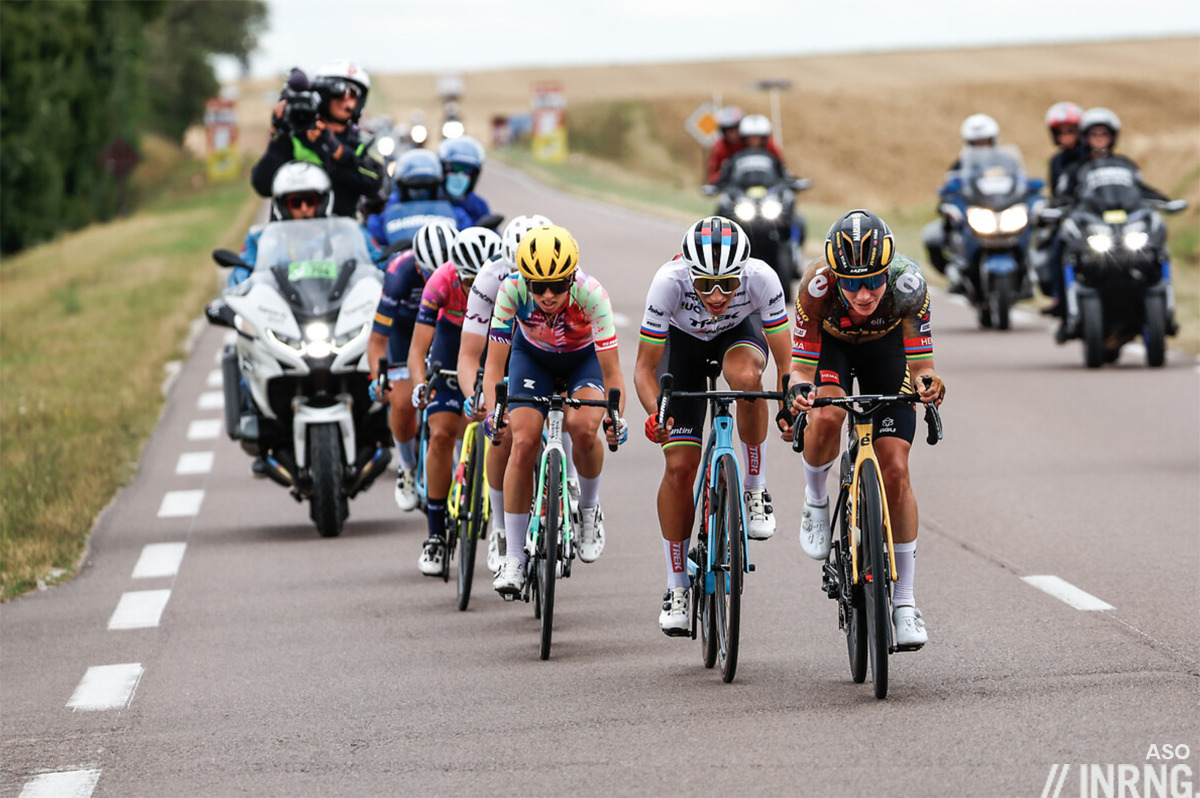
Monday’s stage looked pretty ordinary on paper, a likely sprint finish in Provins. But the wind was up and the stage took an air of a frantic day Paris-Nice, one of those early stages that are a procession if it’s a still day, but an instant semi-classic if there’s a breeze because the vast cereal fields leave the race exposed to crosswinds. But as exciting as it was to see the tension build, a series of crashes spoilt the day. The FDJ-Suez-Futuroscope team fared badly, only one rider in Evita Muzic made the split while team leader and podium contender Marta Cavalli was out. Using the intermediate sprint across the finish line as a pretext, a group of riders got away and stayed away with Marianne Vos taking the stage and the yellow jersey, one of the few things missing from her trophy room.

Stage 3 went to Epernay. The Tour de France Femmes being a new race, ASO director Christian Prudhomme said that while he can have 300 towns queuing to host the men’s race, he had to knock on a few doors to find places to welcome a new event and Epernay’s mayor is an avid cycling fan so this was probably an open door. The mayor even designed with the finishing circuit through the vineyards used in 2019 when Julian Alaphilippe won and this was borrowed again. The steep climbs were a launchpad for attacks but one absentee was Annemiek van Vleuten, dropped and chasing alone at one point. This was an unusual sight but she got back with the lead group of ten on the approach to Epernay and Cecilie Uttrup Ludwig won with a well-timed punchy sprint and delivered one of her trademark post-stage interviews and a remarkable turn around for the FDJ team.
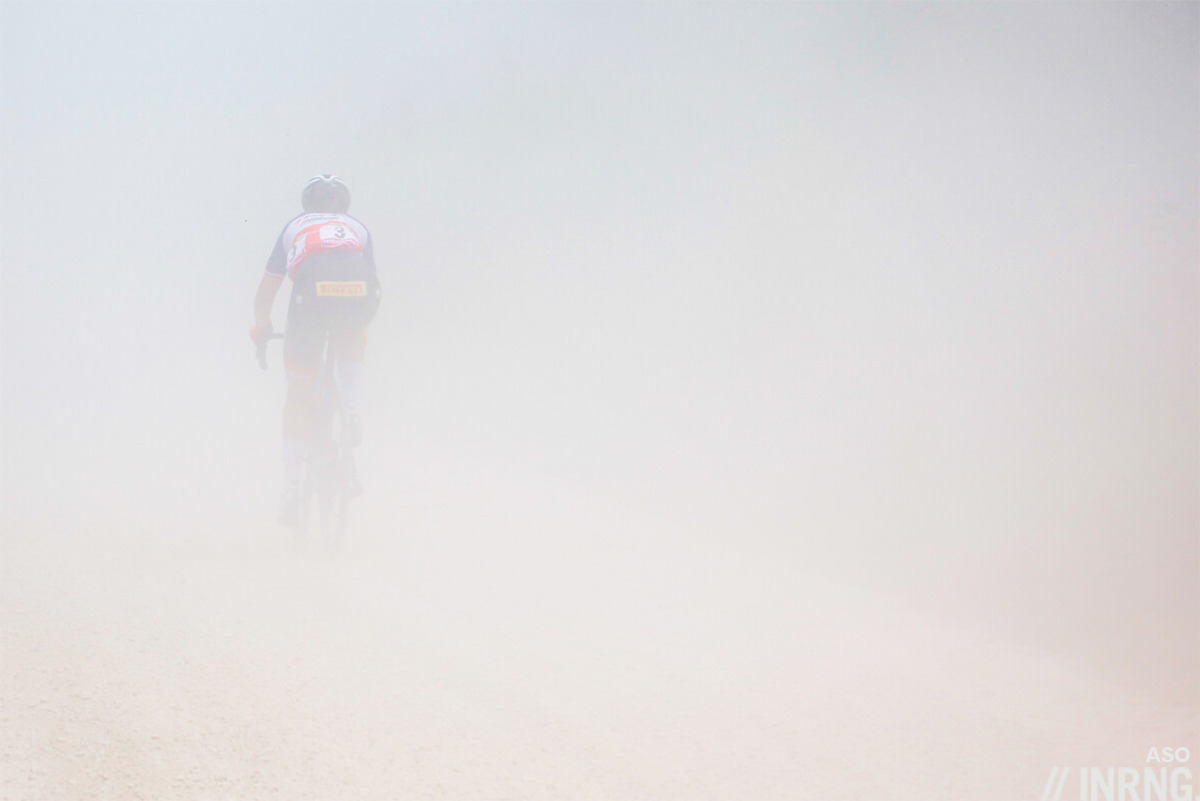
Stage 4 went to Bar-sur-Aube but the story wasn’t where the race went, but how it got there as this marked the introduction of gravel roads. These didn’t prove too ruinous and the worst off was Mavi Garcia who had a series of bike changes and then, on her way back from the team car, overlapped her back wheel with the car and fell to the ground, a scary crash but she and her bike rolled away from danger. She’d lose a minute and half on the day and her injuries weakened any subsequent bid for the podium. One by one Van Vleuten’s challengers were falling away while up ahead Marlen Reusser soloed away for a stage win. A gravel gimmick? Debate will rage in corners of the internet but like the pavé stage for the men it’s a rating hit and helps prevent repeated processional bunch sprints so these things are here to stay.
Could rivals not regret putting van Vleuten out of the GC when she was ill? Easier said than done, for starters it would require rivals to cooperate just to ditch van Vleuten at the expense of their shot at a stage win. Plus it was relative because if they’d put two minutes into her on the stage to Epernay she’d have taken it back.

Stage 5 was a likely sprint finish and Lorena Wiebes duly won, an expected result and her power showed she was the torque of the town in Saint-Dié-des-Vosges but still trailing Marianne Vos in the points competition, Wiebes was only borrowing the green jersey because Vos was in yellow. The next day Wiebes crashed on a descent and Vos winning the stage, the Jumbo-Visma was now in green for good.
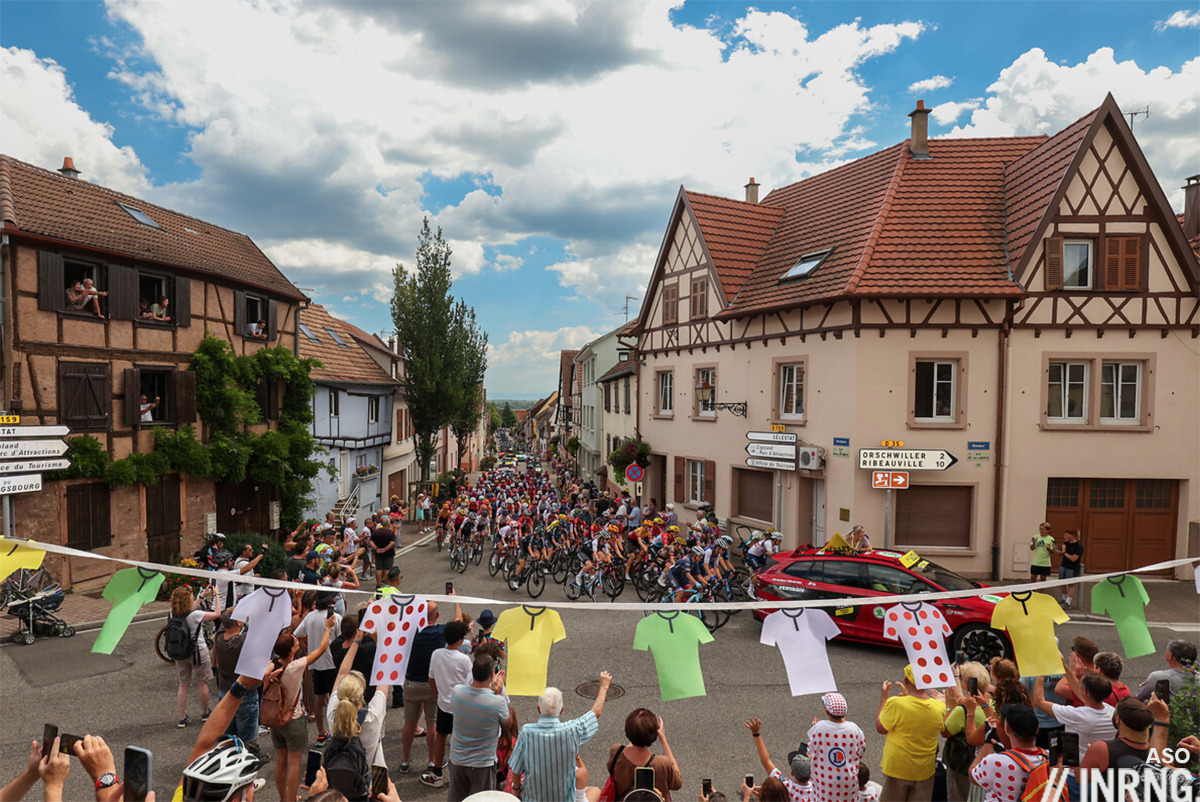
Stage 7 and the race went into the Vosges mountains. You could try and spin this as a tale of the race as going here first, just as the Tour de France went to the Vosges in 1905 for the Ballon d’Alsace before it ventured into the Alps or Pyrenees. Or even that the Planche des Belles Filles sounded like a fitting ending; although L’Equipe’s cartoonist Vidberg mocked that it should be renamed as the Planche des Beaux Mecs for the day. But it is as good a place as any to race bikes.
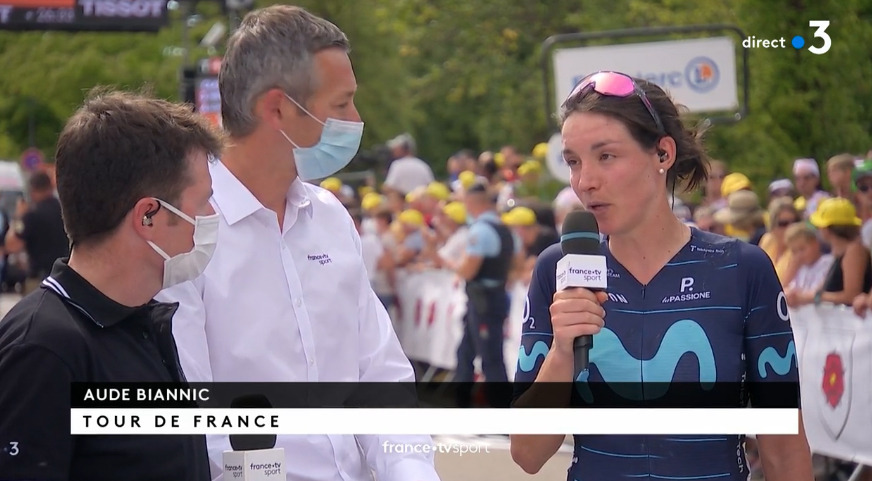
Van Vleuten’s attack on the Petit Ballon wasn’t so much as telegraphed but broadcast on live TV the day before. Here’s French selector Paul Brousse, in his role during the week as a TV pundit, speaking to Movistar’s Aude Biannic on FranceTV (translated):
Brousse: “tomorrow, how’s it going to go down? Annemiek, we know her, she might attack from the start or on the first climb”
Biannic: “Yes. She’s reconned the two stages for Saturday and Sunday and they’re stages that are harder than the mountain stages of the Giro, there’s enough to get going with. I think the time she’s lost on GC, for her, it’s not much.“
Biannic was hardly lifting the lid on surprise tactics, no cat was being let out of the bag. A Van Vleuten long range attack is up there with night following day or the revelation that dogs bark. But when it happened nobody could do anything about it either. Up the Petit Ballon and Van Vleuten was forcing the pedals over. Vollering looked smooth, legs turning evenly but her head began to tilt to one side and soon after she was wincing. On the descent Vollering tried to pressure Van Vleuten as descending is her glaring weakness but the difference was only seconds and Vollering seemed to sit up and wait at the start of the Col de Platzerwasel. Resignation? Perhaps but Van Vleuten quickly took over and Vollering was better off in the wheel taking what shelter she could get. Then Van Vleuten accelerated, it wasn’t a blazing attack as there was no need for surprise but instead adding 10-20 watts sufficed to ride away.
Stage 8 and Van Vleuten was well in the lead and looked capable of winning the stage. And yet… she had a mechanical coming off Col des Croix. A borrowed bike, a bike change, only two team mates with her and she was losing ground as SD Worx picked up the pace ahead. This was toying with the unwritten rule about attacking when a rival’s in trouble, especially if they’re standing beside the road without a bike for a moment. But this is what we could see on TV, it’s not clear how much the team knew and they could just have been trying to pressure Van Vleuten on a descent. They couldn’t shake her on the climb though and she got back on the start of the Grand Ballon climb, only to drop back to the team car for water bottles, and then a bike change. With the breakaway swept up on the first ramps of La Planche, Van Vleuten rode away for the stage win but this time was grinding out time but sufficient to ensure she won solo on the yellow jersey.

As the chart shows Van Vleuten was never in trouble, if she was ill, her time losses were limited and the GC contenders were really only losing time to Marianne Vos during the opening six days. The race might have been different with Marta Cavalli present, Ashley Moolman healthy and Mavi Garcia uninjured but probably this would have shaped the fight for the other steps of the podium.
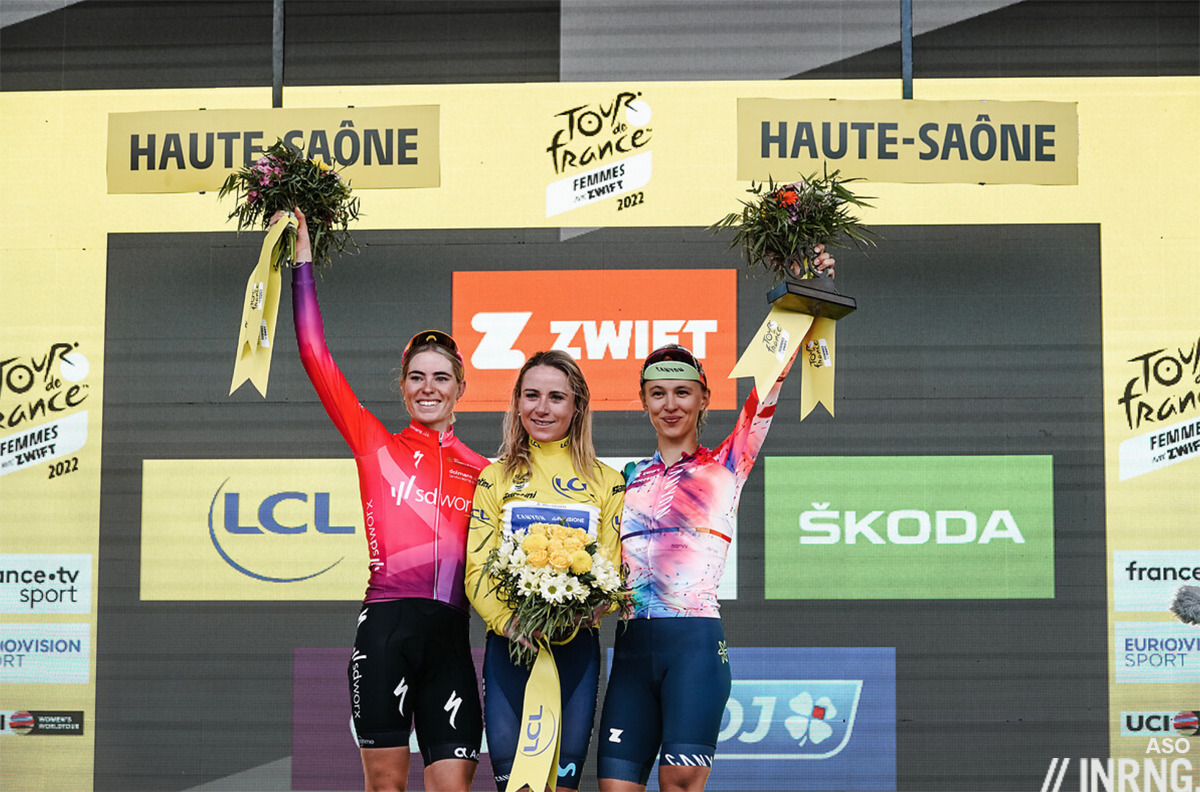
The Verdict
An enjoyable race, there was action and variety along the way and if the arch-favourite won thanks to a crushing ride in the Vosges, others were the mix for most of the week. Plus, for a brief moment on Sunday, Van Vleuten was on the back foot again and had to overcome some descending and mechanical woes to triumph. The podium places were hard fought and Vollering cemented her second place while Niewiadoma rode to third. Fourth-placed Labous helped boost home interest in France and Silvia Persico was the surprise of the race, building on a strong Giro.
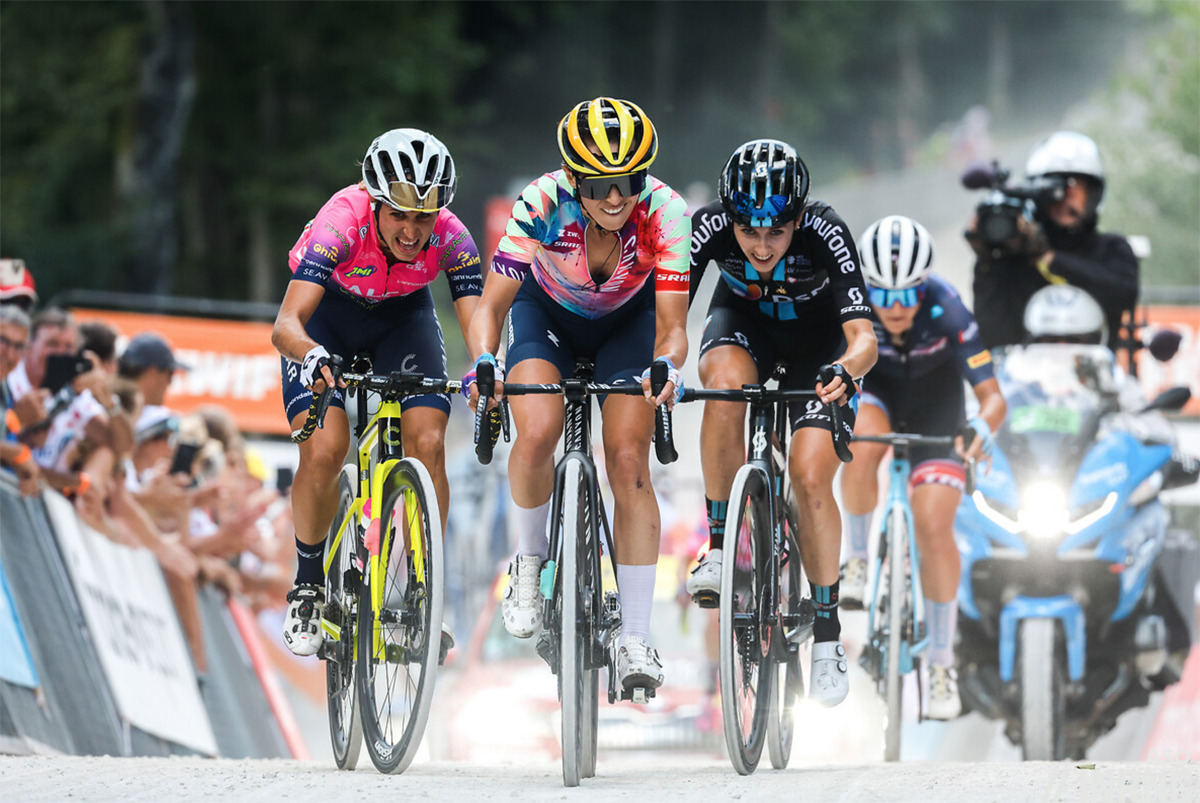
It was also greatly satisfying for all the other things it represented. The Tour de France Femmes is back for the first time since 1989. Yes there have been races in between but if you’d visited the Grande Boucle Feminine a decade ago you’d have seen a modest race that was amateur, in the kind sense, in terms of organisation. This was very much the Tour de France, visually it looked like the men’s race with the same hoardings at the top of a climb, the same finish arch, the same farmer field displays, the same Cochonou bob hats from the caravanne, the same mass of camping cars, the same TV production.
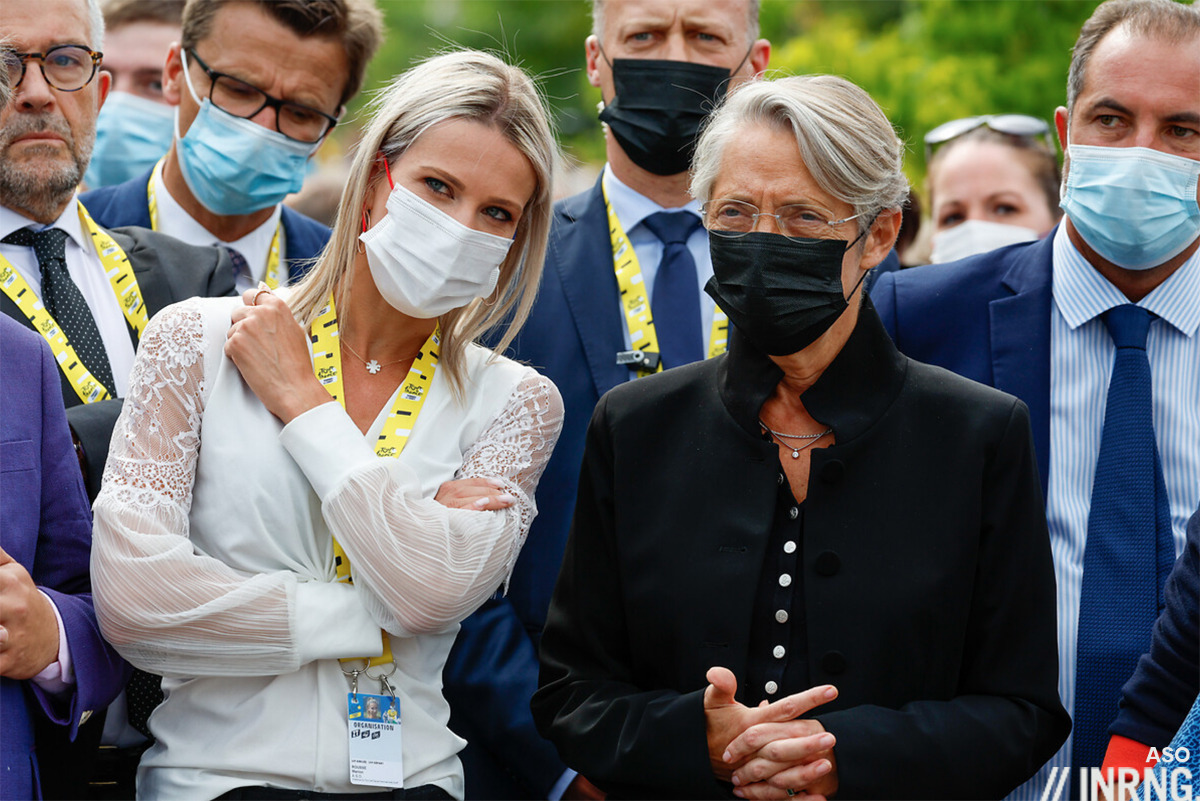
It’s also got the same political goodwill, when French President Emmanuel Macron attended the Tour stage to Hautacam, a week later the Prime Minister Elisabeth Borne was at the race, a sign that matters in both directions as the Tour relies on politicians and various layers of national, regional and local government; plus if a politician wants to be seen at the race it’s because they know there’s an audience. It even sounded the same with the soundtrack of “allez, allez” along route. For sure it’s not as big but no other race is either, men’s or women’s. It looked impressive and anecdotally the race attracted a lot of women and girls who can now see a road ahead that didn’t exist before.
As everyone knows, the Tour de France was created to sell newspapers and it’s been a business ever since. Yes it is a sporting event, but a consumer and a cultural product too. Launching the Tour de France Femmes was akin to Coca Cola putting a new flavour on the market. This one passed the taste test and probably surpassed many expectations. It’s been ratings hit in France, with millions tuning in on free-to-air French TV, the race reached a reported 20 million TV viewers with an average audience of 2.1 million viewers across the eight days and a respectable 25% market share for France 3 and a peak of 5.1 million. During the men’s race, TV ad breaks featured a promo for the women’s race and this helped spread the message that the women’s race was coming – you knew, I knew but the issue is telling everyone else and for a first edition this was very good.

Like one of those job interview questions when a candidate is asked to list their weaknesses and they reply that they’re a perfectionist or prone to working too hard, perhaps the only fault all week was the extent of the TV coverage: there wasn’t enough for Stage 7 when the race was been blown to bits up the Petit Ballon. But the big audience should convince FranceTV to augment its coverage. The mid-afternoon slot in France is not brimming with hit shows, instead it’s old repeats but they’re cheaper than a bike race which costs a small fortune to produce. These audience ratings should make it worthwhile with the hope that FranceTV will offer start to finish TV coverage, at least for the weekend mountain stages. And if we’re being picky, this new race has sprung up all of a sudden looks set to dominate the calender in the way the men’s race does too: ASO suddenly get the biggest slice of a new cake and it’s the Giro Donne that is slated to move on the calendar in adjustment. But if the race gets quality organisation, known branding and widespread media coverage, good luck complaining.
What next? More of the same. If it’s been a ratings success in France, only a handful of the mainstream free-to-air channels that show the Tour de France picked up the Tour de France Femmes in full. Now you might enjoy the coverage on Eurosport or Peacock Premium, just as you read a niche cycling blog from time to time, but it’s the mass market audience that matters, channels pumped into people’s homes where the audience is measured in millions, not thousands. This has already brought in a blue-chip sponsor like Suez and convinced Cofidis and Arkéa to start women’s teams, and broader TV coverage in more countries will bring in more sponsors from more countries and create a virtuous cycle of more investment leading to a denser field and better racing; more viewers means more host towns will knock on ASO’s door bringing options for the route too.
The event’s format is likely to stay similar. The eight day program is hard to change, if the race is to pick up where the men’s Tour de France leaves off then it has to start on a Sunday and it would be unthinkable to finish mid-week were the race to be extended to, say, 10 or 12 days because the weekend rhymes with better TV ratings both in terms of quantity and quality. So a two week race? Sure but not next year. A time trial stage? While the specialists obviously crave them, they’re not good for ratings and also tend to reward the big squads who can fund wind tunnel trips and sets of custom handlebars while some of the participant smaller teams don’t have dedicated time trial bikes, just disc wheels and clip-on bars.
For all the structural possibilities in the years to come, for now it’s just comforting to look forward to the race route presentation on 27 October and wonder where the race will be heading. The Tour de France is now a four week festival and women’s cycling is now growing fast, you could enjoy this race for the sport but also a witness to the start of something big. They’ll be plenty to chew on over the winter and when it’s too cold or dark to ride outside, I’ll be renewing my winter subscription to Zwift.


Quick note (please delete) – there’s something very wrong with your ‘GC relative to AvV’ graph.
I can’t see what it is. Remember it’s relative to AvV and not the GC standings each day, eg to Vos.
I apologize, the discrepancies weren’t as big as I remembered, but I think stage 2 Niewiadoma and Persico were 38 s ahead and Longo Borghini 32 s (Vollering +5 s, which is probably accurate with what you have since the bars are so thick), and stages 3 through 6 Niewiadoma/Persico +58 s, LB +53 s, Vollering +17 s, Labouse +9 s if I’ve done my math correctly.
No worries. I’ve been using the same kind of chart for several years now for the grand tours, nice to use it for this race. The version used for the Tour saw the axes shift like never before thanks to the huge time gaps, things got more compressed again for this race.
But even with the compression shouldn’t the chart show Niewiadoma, Persico, and Longo Borghini appreciably ahead of Van Vleuten in stages 2-6? The way it looks now, all the contenders except Uttrup Ludwig were in a dead heat through those stages. The chart seems to be missing any positive values on the x-axis, and so is obliterating those differences in the plotted lines.
Yes! Now it makes sense. And thanks for the great write up!
I love Vos and AvV but part of me wishes they’d retire so we could see a bit less predictability.
I think we’ll see things in a different way, they are bound to retire but the field as a whole will get closer together, those behind will be able train more, have more support and a wider pool of athletes and talent detection will draw more in.
It’s another story but something that’s also happened with the men’s field, the difference between the 10th and 100th rider in many races is has really narrowed. You now have people doing altitude training camps as preparation for the Tour de Wallonie when not long ago it was reserved for a select few ahead of big goals like a grand tour contender.
Vollering said she couldn’t attack hard on the stage 7 descent because she had to sit up to keep food and drink down.
The TDFF was a good watch. It helped that the crowds were big to lend excitement to the broadcasts. The crashes, though unfortunate, made some of the more potentially boring stages more interesting. Glad they left the mountains until last to keep some suspense earlier, rather than AvV just riding away on stage 2.
Technically, AvV was not filling well earlier, so mountains earlier could have served up a surprise and have made the battle for the last weekend even more exciting. Of course, one can’t plan for such things and the race format made a lot of sense.
Inrng,
Thank you for the great write-up.
Overall I think this is a really good thing for women’s sports.
It will be interesting to see how US sponsors participate, as the capacity/need to balance spending for both genders is high.
Likewise, the US appetite for watching women’s sports is quite high…
(On a side note Silicon Valley Bank – co-sponsor of the EF-Education women’s team is now the 13th largest US Bank by assets per the Fed, if some of their well-funded competitors, or better yet, their customers it would be helpful.)
The US side is interesting. If the race can get more mainstream coverage in the US – think NBC more than Peacock Prime – then the sponsorship dollars ought to flow, it’s possible to imagine this happening quite separately from the men’s teams. Some more American success will help but some strong rides show it’s possible.
“It will be interesting to see how US sponsors participate”
The big sponsor already is an American company: Zwift. I even think the official name of the event was Tour de France Femmes avec Zwift. Their banner also were all over the parcours.
It would have been nice if ASO and the UCI would have let them have two team cars, like the men.
That’s a UCI rule where currently only the men’s World Tour automatically has two cars in the race convoy, it’s down to resources, the idea being that they’re sufficiently funded and equipped to have enough vehicles, staff, spares etc. Hopefully everything can catch up.
Great to see this!
Many thanks for the great write-up. Enjoyed watching the race very much. AvV is obviously on a Level of her own, her dedication is special. But I hope, the prospect of wearing the famous yellow jersey will further improve the competition in next years.
An 8 day race seems appropriate for the moment. You need more depth in the field to keep going for longer especially. Not enough quality domestiques. But the extra exposure will lead to more money which lead to more racing and quality riders.
I,m not sure about the 24 teams of 6 riders though. Less teams and an extra rider per team might be better because 24 teams must be stretching the quality gap between the front and back ends a bit much. And 6 riders is just a bit light.
Another interesting write-up. Maybe next year if time allows, we could see stage previews for the women as well?
To me it was really pleasant to watch the TDFF and to me it felt long overdue.
I personally believe it would be great for the race to expand to two weeks – start on Sunday in Paris when the men finish, go until the next Sunday, rest on Monday, and then 6 more stages. Maybe the last one can be a procession with a sprint like the men’s race, maybe in a different city.
Agree – I’d keep it at 8 days for the next, say 5 years, then re-assess where the women’s peloton is. As you say, the field needs more depth. Also, currently the women’s peloton favours the sprinter/ puncheurs, rather than out and out climbers, as that is what most races tend to feature – not the multiple climbs we saw on the last two stages. I also think a ITT is needed, probably early in the race.
Anyway, it was a success and hopefully will grow. Oh, and there needs to be a larger gap between the Giro Donne and TdFF – all completed inside a month needs looking at.
Thank you for the wonderful write up.
Since my first daughter was born 6 years ago – she and I have spent the mornings of July (we’re in California) watching the mens Tour. Each year she would get more and more excited as she got older and understood more. She is absolutely our of her mind excited that there is a women’s Tour now.
It is true that seeing yourself or seeing someone who represents a portion of who you are on TV competing makes a big difference.
We’re very thankful ASO have restarted the TDFF and can’t wait until next year!
Thanks for the review.
“Torque of the town”, a wonderful line!
Movistar’s season saved?
I think it was the day most expected…
Every year since I started watching TdF, I think of buying a bike and training so I could visit some of the climbs and enjoy it from an amateur cyclist’s perspective. This year instead, I dreamed of being a cyclist and doing the TdFF! This is the kind of thing one would not understand unless you belong to an underrepresented group.
Thanks for your text, loved it!
It was an excellent race!
I found the category 4 climb on the Champs-Élysées a bit embarrassing – hopefully there’s a more representative climb on stage 1 next year. Perhaps the steep slopes of Montmartre (7% over 1km) as rumoured for the Paris 2024 road race – just 4km from the traditional circuit…
The climb was just a sprint but allowed them to award the mountains jersey that day.
Thanks for the wonderful write up and appreciation of this fabulous and entertaining race, Jr. Inrng.
One request: the picture above of the #3 rider in the dust (I guess it is Audrey Cordon-Ragot of Trek-Segafredo) is amazing. Where did you find it and any chance to acquire a digital copy? Any advise is appreciated
The photo is of Audrey Cordon-Ragot, yes. It’s from ASO and their media website, not sure if it’s available to buy, I don’t think so.
Many thanks, well appreciated. I’ll see what I can do.